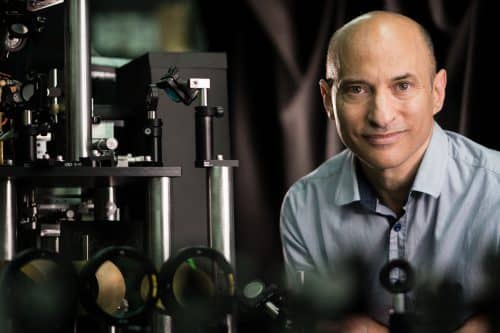In an article published in the journal Nature Physics in early 2021, the research group showed that permanent (stationary) Hawking radiation was indeed emitted from the acoustic black hole. They measured 97,000 repetitions of the experiment, which is equivalent to 124 days of continuous measurement, and observed spontaneous Hawking radiation at six different times after the formation of the acoustic black hole.

Stephen Hawking predicted that a black hole - a celestial object with such strong gravity that nothing can escape its grip - emits radiation similar to a hot object ("black body radiation", constant radiation that is emitted only depending on the temperature of the body), like a star. Therefore, black holes will not only emit radiation, but this "Hawking radiation" will be constant over time, similar to radiation from a black body. The temperature of Hawking radiation is determined by gravity at the surface. The bigger it is, the higher the temperature. Although Hawking's prediction will soon celebrate its anniversary, Hawking radiation has not yet been measured in ordinary (celestial) black holes because the temperature is expected to be too low, in the nano-Kelvin scale and below.
The research group of Prof. Jeff Steinhauer from the Faculty of Physics The Technion created an acoustic black hole - a system where sound waves cannot escape, in analogy to real black holes from which light waves cannot escape beyond the spherical surface called the event horizon. In an article published in the journal Nature physics In early 2021, the research group showed that permanent (stationary) Hawking radiation was indeed emitted from the acoustic black hole. They measured 97,000 repetitions of the experiment, which is equivalent to 124 days of continuous measurement, and observed spontaneous Hawking radiation at six different times after the formation of the acoustic black hole, and also saw that the temperature and intensity of the radiation remained constant over time. Moreover, they followed the evolution of Hawking radiation throughout the lifetime of the acoustic black hole and compared it to the radiation expected to be emitted from real black holes. In the first step, they observed the intensification of the radiation similar to the radiation expected during the formation of ordinary black holes. The constant fluorescence was then observed.
The stationary phase of Hawking radiation in the acoustic black hole came to an end with the formation of an inner horizon, a spherical surface inside the black hole, inside which sound waves are no longer trapped by the black hole. This inner horizon emitted radiation that forced additional Hawking radiation from the black hole and resulted in a significant increase in the Hawking radiation measured from the system.
First laboratory confirmation of Hawking's prediction
"Prof. Jeff Steinhauer's experimental results are of great importance and interest. Jeff measures Hawking radiation emitted from an analog black hole at a constant rate, in accordance with Hawking's theoretical prediction. This gives very significant experimental support to Hawking's analysis, which actually receives experimental confirmation for the first time in Jeff's experiments," says Prof. Amos Uri from the Faculty of Physics at the Technion, who is an expert in general relativity and black holes.
"However," adds Prof. Uri, "the current experiment also showed that after a certain time, the radiation emitted from the analog system begins to intensify significantly, apparently due to the development of forced radiation following the formation of the inner horizon. This is a phenomenon that is no longer included in Hawking's analysis, so in my eyes it is much more interesting. The phenomena observed in this experiment raise the following question: Can real black holes also emit strong forced radiation, as did the acoustic black hole in Jeff's experiment? In my eyes, this is a fascinating question, and of critical importance to the physics of black holes as well as to astrophysics and cosmology."
These groundbreaking results shine a spotlight and provide the scientific community with significant insights into the nature of acoustic and celestial black holes. "Our new long-term goal," concludes Steinhauer, "is to see what happens when you study physics beyond the approximations used by Hawking, approximations in which Hawking radiation is quantum but space-time is classical. In other words, we want to take into account that the acoustic black hole consists of approximately point particles."
To the home page of Professor Jeff Steinhauer:
for an article in the scientific journal Nature physics
More of the topic in Hayadan:

2 תגובות
Has anything really been measured? Does gravity even exist? What can even be measured?
I argue that gravity does not exist at all, and the time has come for a new theory about the structure of the universe.
The two fundamental concepts in the Newtonian universe are force and matter
The two fundamental concepts in the Einsteinian universe are energy and matter
The two fundamental concepts in the neural universe are passive time and energy
The material in the neural universe is not a quantitative concept, and is in the nature of a physical form.
This physical form is created by combining amounts of passive time and energy.
A geometric shape is created by combining quantities of volume and surface area, or of perimeter and area.
In the neural universe, gravity does not exist, and the stars have eternal motion in helical orbits.
Detail of the new universe, in the attached article
http://img2.timg.co.il/forums/2/ac193a50-8b58-4711-89bd-475f16879d2a.pdf
Perhaps the research group of Prof. Jeff Steinhauer from the Faculty of Physics is ready to perform an innovative measurement that appears in the scope experiment?
Thanks
https://youtu.be/HY7GQxU1HLk